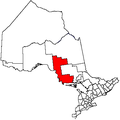| People | Ojibwe, Odawa, Potawatomi |
|---|---|
| Treaty | Robinson Huron |
| Headquarters | P.O. Box 2230, Sagamok |
| Province | Ontario |
| Land [1] | |
| Main reserve | Sagamok |
| Land area | 113.95 km2 |
| Population (2024) [2] | |
| On reserve | 1615 |
| On other land | 28 |
| Off reserve | 1652 |
| Total population | 3295 |
| Government [3] | |
| Chief | Angus Toulouse |
| Council | Anna Marie Abitong Michael Abitong Arnolda Bennett Leroy Bennett Nicole Eshkakogan Paul Eshkakogan Lawrence Solomon Sr. Rhonda Stoneypoint-Trudeau Angus Toulouse McKenzie Toulouse Sheldon Toulouse William Toulouse |
| Tribal Council [4] | |
| Anishinabek Nation Mamaweswen, The North Shore Tribal Council | |
| Website | |
| https://www.sagamokanishnawbek.com/ | |
Sagamok | |
|---|---|
| Sagamok Indian Reserve | |
 Council building | |
| Coordinates: 46°10′N82°13′W / 46.167°N 82.217°W | |
| Country | |
| Province | |
| District | Algoma |
| First Nation | Sagamok Anishnawbek |
| Government | |
| • Chief | Angus Toulouse |
| Area | |
| • Land | 98.72 km2 (38.12 sq mi) |
| Population (2011) [5] | |
• Total | 1,036 |
| • Density | 10.5/km2 (27/sq mi) |
| Website | www.sagamok.ca |
The Sagamok Anishnawbek First Nation, also known as Many Rivers Joining-Human Beings, [6] is a First Nations band government located in Ontario, Canada. Sagamok's culture and language is Anishinabek and is made up of the Ojibwe, Odawa and Pottawatomi bands. The Sagamok occupy the Sagamok reserve approximately 120 kilometres west of Sudbury, Ontario, and have a population of approximately 1650. [7]
Contents
In the early years of Canada's development, the French relied on Sagamok's strategic location to trade with the local Anishnaabe people of that time. [6] The French base of operations was the nearby Fort La Cloche.

